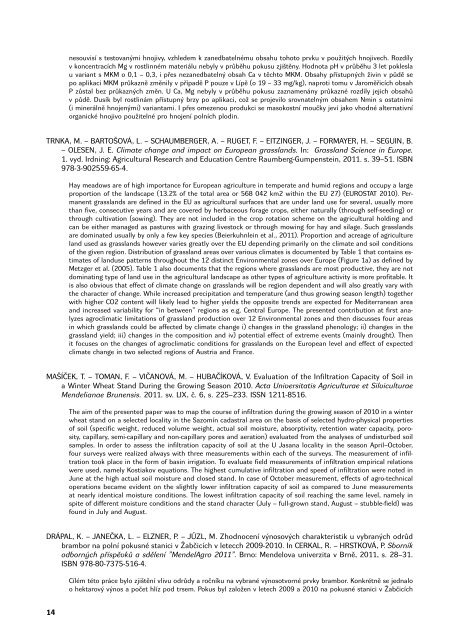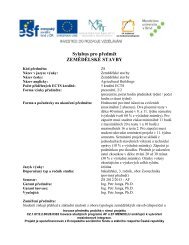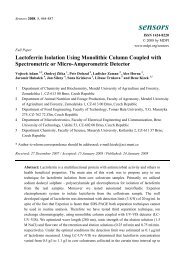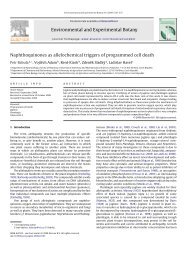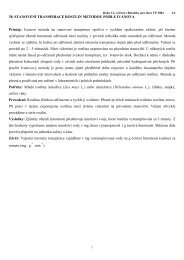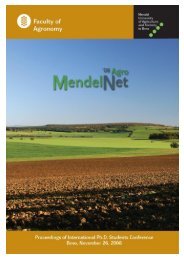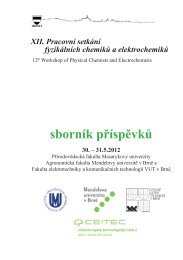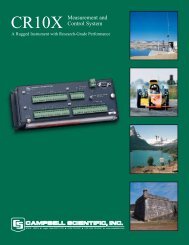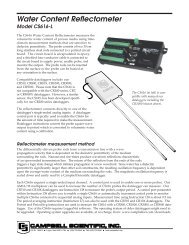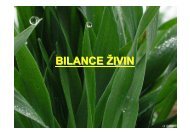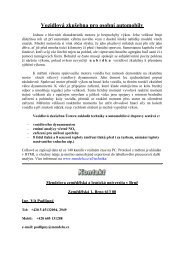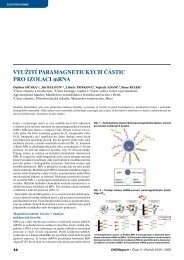nesouvisí s testovanými hnojivy, vzhledem k zanedbatelnému obsahu tohoto prvku v použitých hnojivech. Rozdílyv koncentracích Mg v rostlinném materiálu nebyly v průběhu pokusu zjištěny. Hodnota pH v průběhu 3 let pokleslau variant s MKM o 0,1 – 0,3, i přes nezanedbatelný obsah Ca v těchto MKM. Obsahy přístupných živin v půdě sepo aplikaci MKM průkazně změnily v případě P pouze v Lípě (o 19 – 33 mg/kg), naproti tomu v Jaroměřicích obsahP zůstal bez průkazných změn. U Ca, Mg nebyly v průběhu pokusu zaznamenány průkazné rozdíly jejich obsahův půdě. Dusík byl rostlinám přístupný brzy po aplikaci, což se projevilo srovnatelným obsahem Nmin s ostatními(i minerálně hnojenými) variantami. I přes omezenou produkci se masokostní moučky jeví jako vhodné alternativníorganické hnojivo použitelné pro hnojení polních plodin.TRNKA, M. – BARTOŠOVÁ, L. – SCHAUMBERGER, A. – RUGET, F. – EITZINGER, J. – FORMAYER, H. – SEGUIN, B.– OLESEN, J. E. Climate change and impact on European grasslands. In: Grassland Science in Europe.1. vyd. Irdning: Agricultural Research and Education Centre Raumberg-Gumpenstein, 2011. s. 39–51. ISBN978-3-902559-65-4.Hay meadows are of high importance for European agriculture in temperate and humid regions and occupy a largeproportion of the landscape (13.2% of the total area or 568 042 km2 within the EU 27) (EUROSTAT 2010). Permanentgrasslands are defined in the EU as agricultural surfaces that are under land use for several, usually morethan five, consecutive years and are covered by herbaceous forage crops, either naturally (through self-seeding) orthrough cultivation (sowing). They are not included in the crop rotation scheme on the agricultural holding andcan be either managed as pastures with grazing livestock or through mowing for hay and silage. Such grasslandsare dominated usually by only a few key species (Beierkuhnlein et al., 2011). Proportion and acreage of agricultureland used as grasslands however varies greatly over the EU depending primarily on the climate and soil conditionsof the given region. Distribution of grassland areas over various climates is documented by Table 1 that contains estimatesof landuse patterns throughout the 12 distinct Environmental zones over Europe (Figure 1a) as defined byMetzger et al. (2005). Table 1 also documents that the regions where grasslands are most productive, they are notdominating type of land use in the agricultural landscape as other types of agriculture activity is more profitable. Itis also obvious that effect of climate change on grasslands will be region dependent and will also greatly vary withthe character of change. While increased precipitation and temperature (and thus growing season length) togetherwith higher CO2 content will likely lead to higher yields the opposite trends are expected for Mediterranean areaand increased variability for “in between” regions as e.g. Central Europe. The presented contribution at first analyzesagroclimatic limitations of grassland production over 12 Environmental zones and then discusses four areasin which grasslands could be affected by climate change i) changes in the grassland phenology; ii) changes in thegrassland yield; iii) changes in the composition and iv) potential effect of extreme events (mainly drought). Thenit focuses on the changes of agroclimatic conditions for grasslands on the European level and effect of expectedclimate change in two selected regions of Austria and France.MAŠÍČEK, T. – TOMAN, F. – VIČANOVÁ, M. – HUBAČÍKOVÁ, V. Evaluation of the Infiltration Capacity of Soil ina Winter Wheat Stand During the Growing Season 2010. Acta Universitatis Agriculturae et SilviculturaeMendelianae Brunensis. 2011. sv. LIX, č. 6, s. 225–233. ISSN 1211-8516.The aim of the presented paper was to map the course of infiltration during the growing season of 2010 in a winterwheat stand on a selected locality in the Sazomín cadastral area on the basis of selected hydro-physical propertiesof soil (specific weight, reduced volume weight, actual soil moisture, absorptivity, retention water capacity, porosity,capillary, semi-capillary and non-capillary pores and aeration) evaluated from the analyses of undisturbed soilsamples. In order to assess the infiltration capacity of soil at the U Jasana locality in the season April–October,four surveys were realized always with three measurements within each of the surveys. The measurement of infiltrationtook place in the form of basin irrigation. To evaluate field measurements of infiltration empirical relationswere used, namely Kostiakov equations. The highest cumulative infiltration and speed of infiltration were noted inJune at the high actual soil moisture and closed stand. In case of October measurement, effects of agro-technicaloperations became evident on the slightly lower infiltration capacity of soil as compared to June measurementsat nearly identical moisture conditions. The lowest infiltration capacity of soil reaching the same level, namely inspite of different moisture conditions and the stand character (July – full-grown stand, August – stubble-field) wasfound in July and August.DRÁPAL, K. – JANEČKA, L. – ELZNER, P. – JŮZL, M. Zhodnocení výnosových charakteristik u vybraných odrůdbrambor na polní pokusné stanici v Žabčicích v letecch 2009-2010. In CERKAL, R. – HRSTKOVÁ, P. Sborníkodborných příspěvků a sdělení ”MendelAgro 2011”. Brno: <strong>Mendelova</strong> <strong>univerzita</strong> v Brně, 2011, s. 28–31.ISBN 978-80-7375-516-4.Cílém této práce bylo zjištění vlivu odrůdy a ročníku na vybrané výnosotvorné prvky brambor. Konkrétně se jednaloo hektarový výnos a počet hlíz pod trsem. Pokus byl založen v letech 2009 a 2010 na pokusné stanici v Žabčicích14
Mendelovy univerzity v Brně. K pokusu byly použity odrůdy s různou délkou vegetační doby, od velmi raných až popolopozdní a odrůdy české a zahraniční. Nejvyššího výnosu dosáhly polorané odrůdy a to průměrně 58 t.ha-1. Zdese potvrdilo, že odrůdy s delší vegetační dobou dosahují vyšších výnosů. V počtu hlíz pod trsem dosáhly nejlepšíhovýsledku odrůdy rané a to v průměru 15,1 ks.trs-1. Průměrně 14,1 ks.trs-1 dosáhly české odrůdy, což byl lepšívýsledek, než vykázaly odrůdy zahraniční. Na základě zjištěných výsledků lze konstatovat, že v lokalitě Žabčice, kdepokus probíhal, se vyplatí z ekonomických důvodů pěstovat brambory raného až poloraného charakteru. Pro velmirané brambory zde nejsou vhodné klimatické podmínky (nízký úhrn srážek a jejich špatné rozložení), protože díkyjejich krátkemu vegetačnímu období nedokáží plně využít jejich výnosový potencionál.NOVOSÁDOVÁ, I. – ZÁHORA, J. – FIŠEROVÁ, H. – RUIZ SINOGA, J. D. Carbon and nitrogen microbial transformationalong a pluviometric gradient in Mediterranean region. In ŠKARPA, P. Proceedings of the InternationalConference Soil, Plant and Food Interactions. 1. vyd. Brno: Mendel University in Brno, 2011,s. 646–652. ISBN 978-80-7375-534-8.The present study is focused in the role of microbial soil properties in Mediterranean environment, in terms of insitu and ex situ microbial transformation of soil carbon and nitrogen, in order to characterise the key soil microbialactivities which could strongly affect carbon and nitrogen turnover in soil fertility and soil organic matter “quality”.The final results shown modifications in the soil properties studied with the increasing of the aridity.VANĚK, P. Chov býložravyých ryb v rybničních podmínkách. Bakalářská práce. odd.Rybářství a hydrobiologie,AF: MENDELU Brno, 2011. 44 s.Předmětem bakalářské práce je zpracování literární rešerše týkající se problematiky chovu býložravých ryb v rybničníchpodmínkách na území České republiky. Zhodnocení současného stavu produkce býložravých ryb a možnostiprodukce násadového materiálu v polykulturních obsádkách s ostatními druhy kaprovitých ryb chovaných v Českérepublice. V kapitole 5 je popsána metodika. Pokus probíhal na rybnících v obci Sosnová v okrese Opava a ve dvouchrakterizovaných rybnících byl popsán pokus využití možnosti přikrmování polními pícninami (vojtěška setá) zaúčelem zvýšení přírůstků násadového materiálu amura bílého a kapra obecného. Porovnání výsledků z obou rybníků,přičemž na jednom z nich bylo prováděno přikrmování vojtěškou setou.VÍTĚZ, T. – HAITL, M. – KARAFIÁT, Z. – MACH, P. – FRYČ, J. – LOŠÁK, T. – SZOSTKOVÁ, M. Use of bio- enzymaticpreparations for enhancement biogas production. Acta Universitatis Agriculturae et SilviculturaeMendelianae Brunensis. 2011. sv. LIX, č. 3, s. 203–209. ISSN 1211-8516.Biogas is a renewable energy resource with high increasing developed in last few decades. It’s big opportunity forstabilization rural areas, concretely agriculture sector. This technology can decentralize supply of energy. The numberof operated biogas plants is rapidly increasing. Biogas plants require a high level of intensity and stableness ofthe process of anaerobic fermentation with biogas production for efficiency treatment, also for good quality of developmentbiogas and fertilization effect of the rest of fermentation. If this is not completed the operator has problemto keep the process in optimal condition for anaerobic fermentation. Researchers have tried different techniques toenhance biogas production. In order to achieve the aforementioned state, it is essential to ensure increased activityof microorganisms that contribute to the anaerobic fermentation. The metabolic activity of microorganisms ispreconditioned by availability of easily decomposable solids. Adding of bacterial and enzymatic cultures into a fermentedsubstrate represents one of the possibilities. The enzymes contained in this preparation are responsiblefor better exposing methanogenic bacteria to the material. The tested bio-enzymatic preparation, APD BIO GAS, isa mixture that contains bacteria and enzymes which are essential for the efficient progress of anaerobic fermentation.The reference biogas laboratory of the Mendel University in Brno was used for the purpose of testing of APDBIOGAS in mesophilic conditions of anaerobic fermentation on a substrate consisting of a mixture of maize silageand liquid manure. The producer of this preparation declare enhancement of quality and quantity of developedbiogas, elimination of smell level of the rest of fermentation its higher homogenity. For the test were used lab scalefermenters of batch type with work volume 0.12 m3. An increase of biogas production by 15% was determinedin connection with addition of the preparation, also with higher decrease of total solids and decrease of organicsubstance in total solids in the fermenter where were used this preparation.HORÁK, K. – ČERNÝ, M. – VOTAVA, J. – FAJMAN, M. Experimentální použití metody kontur ke stanovení hodnotyreziduálních napětí v podpovrchových vrstvách. [CD-ROM]. In Kvalita a spoľahlivosť technických systémov– Zborník vedeckých prác. s. 123–129. ISBN 978-80-552-0595-3.The recently developed contour method is ranked among the destructive methods of measuring of residual stress.The complex value of residual stress is calculated by measuring of deformation released by cutting the sample in15
- Page 1: Mendelova univerzita v BrněPublika
- Page 5 and 6: Selenium (Se) is an important eleme
- Page 7 and 8: infiltrace byl prováděn odběr ne
- Page 9 and 10: STŘEDA, T. - DOSTÁL, V. - HAJZLER
- Page 11 and 12: a Vlk & Černý (2001). Polyfágní
- Page 13: JANEČKA, L. - ELZNER, P. - JŮZL,
- Page 17 and 18: as follows: a) three cuts/180 kg N+
- Page 19 and 20: 1. vyd. USA: Edward Elgar Publishin
- Page 21 and 22: on the quality of some small berrie
- Page 23 and 24: BARTOŠOVÁ, L. - TRNKA, M. - BALEK
- Page 25 and 26: number of protozoa in the rumen of
- Page 27 and 28: were compared with simple floristic
- Page 29 and 30: ORSÁG, M. - FISCHER, M. - TRNKA, M
- Page 31 and 32: trav bez vegetačního krytu na jih
- Page 33 and 34: Metodika je zaměřena na vyhodnoce
- Page 35 and 36: a délky kvetení s přihlédnutím
- Page 37 and 38: výnosových parametrů ozimé řep
- Page 39 and 40: DVOŘÁK, J. - SMUTNÝ, V. Vlivy os
- Page 41 and 42: Předmětem výzkumu bylo posoudit
- Page 43 and 44: many different oily crops used for
- Page 45 and 46: steppe dominated by Stipa tenacissi
- Page 47 and 48: MENDELOVA UNIVERZITA V BRNĚ. Sada
- Page 49 and 50: její rozdělení, příčiny, nás
- Page 51 and 52: v růstu ryb mezi jednotlivými ná
- Page 53 and 54: MENDELOVA UNIVERZITA V BRNĚ. Odbě
- Page 55 and 56: and had fewer isolated occurrences
- Page 57 and 58: Vzhledem k rozšiřujícímu se vyu
- Page 59 and 60: M. - EITZINGER, J. - MÁLEK, J. - F
- Page 61 and 62: level of 25 mg/kg (S0) to 35 mg/kg
- Page 63 and 64: Technologists. Book of Abstracts. 1
- Page 65 and 66:
Cílem našeho experimentu bylo pro
- Page 67:
Publikační činnostProjekt: Biolo


